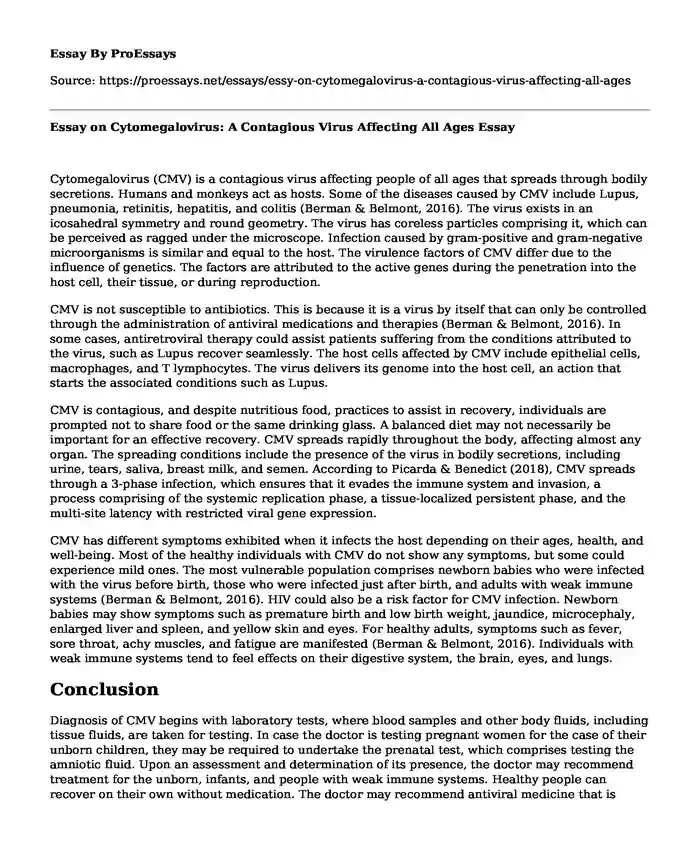Cytomegalovirus (CMV) is a contagious virus affecting people of all ages that spreads through bodily secretions. Humans and monkeys act as hosts. Some of the diseases caused by CMV include Lupus, pneumonia, retinitis, hepatitis, and colitis (Berman & Belmont, 2016). The virus exists in an icosahedral symmetry and round geometry. The virus has coreless particles comprising it, which can be perceived as ragged under the microscope. Infection caused by gram-positive and gram-negative microorganisms is similar and equal to the host. The virulence factors of CMV differ due to the influence of genetics. The factors are attributed to the active genes during the penetration into the host cell, their tissue, or during reproduction.
CMV is not susceptible to antibiotics. This is because it is a virus by itself that can only be controlled through the administration of antiviral medications and therapies (Berman & Belmont, 2016). In some cases, antiretroviral therapy could assist patients suffering from the conditions attributed to the virus, such as Lupus recover seamlessly. The host cells affected by CMV include epithelial cells, macrophages, and T lymphocytes. The virus delivers its genome into the host cell, an action that starts the associated conditions such as Lupus.
CMV is contagious, and despite nutritious food, practices to assist in recovery, individuals are prompted not to share food or the same drinking glass. A balanced diet may not necessarily be important for an effective recovery. CMV spreads rapidly throughout the body, affecting almost any organ. The spreading conditions include the presence of the virus in bodily secretions, including urine, tears, saliva, breast milk, and semen. According to Picarda & Benedict (2018), CMV spreads through a 3-phase infection, which ensures that it evades the immune system and invasion, a process comprising of the systemic replication phase, a tissue-localized persistent phase, and the multi-site latency with restricted viral gene expression.
CMV has different symptoms exhibited when it infects the host depending on their ages, health, and well-being. Most of the healthy individuals with CMV do not show any symptoms, but some could experience mild ones. The most vulnerable population comprises newborn babies who were infected with the virus before birth, those who were infected just after birth, and adults with weak immune systems (Berman & Belmont, 2016). HIV could also be a risk factor for CMV infection. Newborn babies may show symptoms such as premature birth and low birth weight, jaundice, microcephaly, enlarged liver and spleen, and yellow skin and eyes. For healthy adults, symptoms such as fever, sore throat, achy muscles, and fatigue are manifested (Berman & Belmont, 2016). Individuals with weak immune systems tend to feel effects on their digestive system, the brain, eyes, and lungs.
Conclusion
Diagnosis of CMV begins with laboratory tests, where blood samples and other body fluids, including tissue fluids, are taken for testing. In case the doctor is testing pregnant women for the case of their unborn children, they may be required to undertake the prenatal test, which comprises testing the amniotic fluid. Upon an assessment and determination of its presence, the doctor may recommend treatment for the unborn, infants, and people with weak immune systems. Healthy people can recover on their own without medication. The doctor may recommend antiviral medicine that is effective depending on the symptoms for the unborn, newly born babies, or people with weak immunes. Preemptive and antiviral therapies are the most commonly adopted forms of therapies for CMV patients (Berman & Belmont, 2016). For patients suffering from HIV and AIDS, antiretroviral therapy combined with preemptive anti-CMV therapy may be required.
References
Berman, N., & Belmont, H. M. (2016). Disseminated cytomegalovirus infection complicating active treatment of systemic lupus erythematosus: An emerging problem. Lupus, 26(4), 431-434. https://doi.org/10.1177/0961203316671817
Picarda, G., & Benedict, C. A. (2018). Cytomegalovirus: Shape-shifting the immune system. The Journal of Immunology, 200(12), 3881-3889. https://doi.org/10.4049/jimmunol.1800171
Cite this page
Essay on Cytomegalovirus: A Contagious Virus Affecting All Ages. (2023, Nov 06). Retrieved from https://proessays.net/essays/essy-on-cytomegalovirus-a-contagious-virus-affecting-all-ages
If you are the original author of this essay and no longer wish to have it published on the ProEssays website, please click below to request its removal:
- HIV Prevention Plan Analysis Paper Example
- Essay on Food Inspections: A Critical Role in Safeguarding Community Health
- Essay Example on Perineal Care: Prevent Burning, Odour & Itching Infections
- Essay Example on Managing Chronic Pain With Cannabis: Pros & Cons
- CJD: A Rare, Fatal Illness Affecting Senior Citizens - Essay Sample
- US FDA: Protecting Public Health & Safety - Essay Sample
- Essay Example on Leveraging Global Markets with Tech & Virtual Health: Healthcare Evolves







